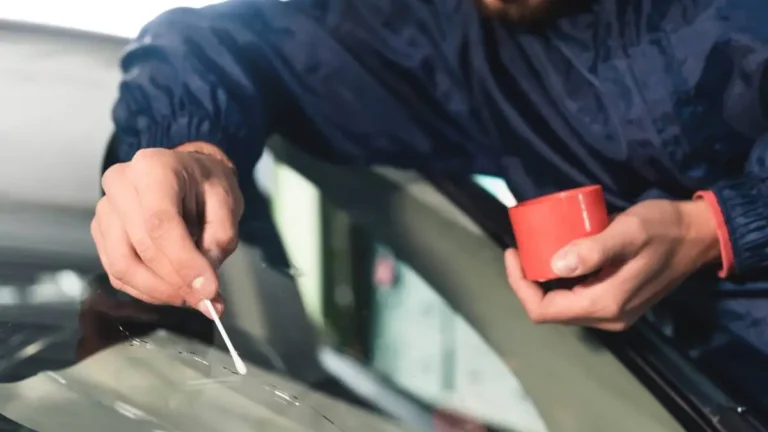Hairline Crack in Windshield | Causes, Risks, and Repairs
A hairline crack in windshield refers to a very fine crack that appears on the surface of a vehicle’s windshield. These cracks are typically thin and subtle, resembling the width of a strand of hair, hence the name. Despite their delicate appearance, hairline cracks can have significant implications for the structural integrity of the windshield and the safety of the vehicle occupants. They commonly occur due to various factors such as changes in temperature, road vibrations, or impact from debris. While they may start small and seemingly inconsequential, hairline cracks can gradually spread and worsen over time if left untreated.
Can a Hairline Crack in Windshield Be Repaired?

Factors Affecting Repairability:
Size and Location:
- The size and location of the crack play a crucial role in determining whether it can be repaired. Hairline cracks, which are typically thin and shallow, are more likely to be repairable compared to larger, deeper cracks.
- Cracks located at the edges of the windshield or in the driver’s line of sight may pose challenges for repair, as they can compromise the structural integrity or obstruct the driver’s view.
Type of Damage:
- Hairline cracks are often considered as minor damage, primarily cosmetic in nature. However, if the crack extends beyond a certain length or depth, it may not be repairable.
- Additionally, if the crack is accompanied by significant splintering or branching, it may indicate underlying structural damage, making repair more difficult.
Timeliness of Repair:
- The sooner a hairline crack is addressed, the better the chances of successful repair. Ignoring the crack can lead to its propagation due to changes in temperature, road vibrations, or exposure to elements.
- Prompt repair not only prevents the crack from spreading but also preserves the integrity of the windshield, reducing the likelihood of more extensive damage requiring replacement.
Exploring Repair Possibilities:
Resin Injection Repair:
- Hairline cracks in windshields are often repaired using a resin injection process. This involves injecting a specialized resin into the crack, which fills the void and restores the structural integrity of the glass.
- The resin is typically cured using ultraviolet light, creating a strong bond that prevents the crack from spreading further.
- This repair method is effective for minor cracks and can be completed relatively quickly, usually within an hour.
DIY Repair Kits:
- Some DIY repair kits are available for repairing hairline cracks in windshields. These kits typically include resin, applicators, and instructions for use.
- While DIY kits may be suitable for very minor cracks, it’s essential to note that professional repair services often yield better results, especially for more significant damage or cracks in critical areas of the windshield.
Importance of Timely Repair:
Safety Concerns:
- A cracked windshield compromises the structural integrity of the vehicle, increasing the risk of injury in the event of a collision.
- Hairline cracks, if left unrepaired, can expand over time, impairing visibility and increasing the likelihood of accidents.
Prevention of Further Damage:
- Prompt repair prevents the crack from spreading, saving the windshield from further damage.
- By addressing the issue early, vehicle owners can avoid more extensive and costly repairs or the need for windshield replacement.
What Causes Hairline Crack in Windshield?
Hairline cracks in windshields can occur due to a variety of factors, including environmental conditions, road debris, impacts, and temperature changes. Let’s delve into each of these causes in detail:
Environmental factors: Windshields are exposed to various environmental conditions such as sunlight, rain, snow, and wind. Over time, prolonged exposure to UV radiation from the sun can weaken the glass, making it more prone to cracking. Additionally, extreme temperature fluctuations can put stress on the glass, leading to microscopic fissures that can eventually develop into hairline cracks.
Road debris and impacts: One of the most common causes of windshield cracks is road debris. Small rocks, gravel, and other debris kicked up by vehicles can strike the windshield at high speeds, creating chips or cracks. Even minor impacts that may not seem significant at first can weaken the glass and eventually lead to the formation of hairline cracks, especially if the windshield has already been compromised by previous damage.
Temperature changes: Glass expands and contracts with changes in temperature. When the temperature fluctuates rapidly, such as during cold nights followed by warm days, or vice versa, the glass undergoes stress due to uneven expansion and contraction. This stress can exacerbate any existing weaknesses in the glass, causing hairline cracks to form or existing cracks to spread.
Risks Associated with Untreated Hairline Cracks
Untreated hairline cracks in various structures, including vehicles, can pose several risks and consequences:
Safety Hazards for Drivers and Passengers:
Structural Integrity: Hairline cracks, if left untreated, can propagate and compromise the structural integrity of the affected component, such as the chassis or frame in a vehicle. This could lead to catastrophic failure, especially under stress or impact conditions.
Accident Risks: Cracks may weaken critical components like the windshield or the frame, increasing the likelihood of accidents, particularly in situations like sudden braking, collisions, or rough terrain driving.
Airbag Deployment: Hairline cracks in areas around airbag deployment zones could affect the deployment or performance of airbags during a collision, potentially leading to inadequate protection for occupants.
Legal Implications:
Liability: If an accident or injury occurs due to a vehicle malfunction caused by untreated hairline cracks, legal liability could arise for the vehicle owner, manufacturer, or maintenance provider. Negligence in maintaining or addressing known issues could result in legal claims against them.
Regulatory Compliance: Depending on jurisdiction, there may be regulations mandating vehicle safety standards. Failure to address known defects like hairline cracks could result in legal penalties or fines.
Financial Consequences:
Repair Costs: Neglecting hairline cracks could lead to more extensive damage over time, necessitating costly repairs or even complete component replacements. Addressing issues early can often prevent further damage and mitigate repair expenses.
Decreased Resale Value: Vehicles with untreated structural issues generally have diminished resale value due to safety concerns. Potential buyers may be hesitant to purchase a vehicle with known defects, or may negotiate a lower price to compensate for the anticipated repair costs.
Hairline Crack Fixing by Professionals
Overview of Professional Repair Services:
Assessment: A professional will inspect the crack to determine its cause, extent, and severity. This evaluation helps in devising an appropriate repair strategy.
Preparation: Surface preparation involves cleaning the area around the crack to remove any debris, loose material, or contaminants that may hinder the repair process.
Repair Techniques: Professionals may use various techniques depending on the type of crack and the underlying structure. Some common techniques include:
Epoxy Injection: This involves injecting epoxy resin into the crack under pressure to fill and seal it.
Repointing or Mortar Repair: For cracks in masonry, repointing or applying mortar can effectively repair the damage.
Carbon Fiber Reinforcement: In cases of structural cracks, carbon fiber reinforcement may be used to strengthen and stabilize the affected area.
Polyurethane Foam Injection: Suitable for hairline cracks in concrete, polyurethane foam expands to fill the crack and create a waterproof seal.
Finishing: After the repair, the surface is often smoothed or refinished to match the surrounding area, ensuring a seamless appearance.
Materials Used:
Epoxy Resin: Used for injecting into cracks to seal and strengthen them.
Polyurethane Foam: Expands to fill cracks and provides waterproofing.
Mortar or Cement: Used for repointing or repairing cracks in masonry.
Carbon Fiber Sheets or Strips: Provides reinforcement for structural repairs.
Cost Considerations:
The cost of professional crack repair can vary depending on factors such as:
Extent of Damage: Larger or more complex cracks may require more extensive repairs.
Materials Used: Different repair techniques and materials have varying costs.
Labor: Professional labor costs can vary based on location, expertise, and the time required for the repair.
Additional Work: If there are underlying issues contributing to the cracks, such as foundation problems, addressing those may incur extra costs.
Conclusion
When facing a hairline crack in a windshield, seeking professional repair services is often the wisest course of action. These cracks, though small, can compromise the structural integrity of the windshield and potentially worsen over time if left untreated. Professional repair technicians possess the expertise and specialized tools necessary to assess the crack’s severity and employ appropriate techniques to address it effectively. Utilizing methods like resin injection, they can fill the crack and restore the windshield’s strength and integrity while minimizing visibility of the repair. Feel free to contact us for any type of query or services related to hairline crack in windshield.
FAQs
What Causes Hairline Cracks In Windshields?
Hairline cracks in windshields can be caused by various factors, including road debris impacts, temperature changes, stress from structural flexing, and underlying defects in the glass.
Are Hairline Cracks Dangerous?
While hairline cracks may seem minor, they can compromise the integrity of the windshield, affecting its ability to withstand impact and potentially leading to further damage or even shattering in the event of a collision.
Can I Drive With A Hairline Crack In My Windshield?
It’s generally not recommended to drive with a hairline crack, as it can worsen due to vibration and changes in temperature. Additionally, depending on local regulations, driving with a cracked windshield may be illegal and result in fines.
Can A Hairline Crack In A Windshield Be Repaired?
Yes, hairline cracks in windshields can often be repaired by professional technicians using specialized techniques such as resin injection. Prompt repair is essential to prevent the crack from spreading and to restore the windshield’s strength.
Will A Repaired Hairline Crack Be Visible?
Professional windshield repair techniques aim to minimize the visibility of the repaired crack, but some faint traces may still be visible upon close inspection. However, the repair should not significantly impair visibility while driving.
How Long Does It Take To Repair A Hairline Crack In A Windshield?
The time required to repair a hairline crack in a windshield can vary depending on factors such as the size and location of the crack, the repair technique used, and the technician’s expertise. In many cases, repairs can be completed in under an hour.

